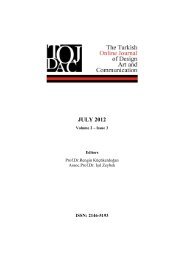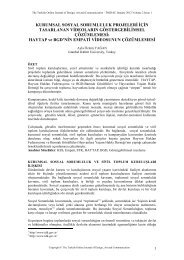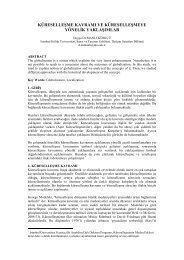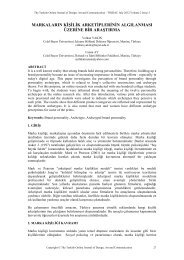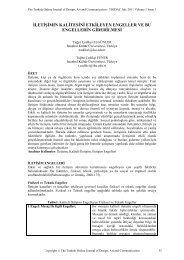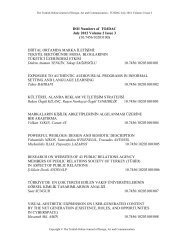aprıl 2012 - tojdac.org
aprıl 2012 - tojdac.org
aprıl 2012 - tojdac.org
You also want an ePaper? Increase the reach of your titles
YUMPU automatically turns print PDFs into web optimized ePapers that Google loves.
The Turkish Online Journal of Design, Art and Communication - TOJDAC April <strong>2012</strong> Volume 2 Issue 2<br />
identity, with a great influence of African descendents. In this sense, people from this region<br />
can fairly be seen as under many different mixtures of colors, that goes beyond black or<br />
white. Consequently by the visitors or co-participants of this installation we can see the<br />
presence of our culture, in a very subtle way.<br />
On the other hand, the installation experience gave an artist a chance to create other works.<br />
The panels gave a new idea: with an overhead projector and other digital projection<br />
equipments, images and texts were projected direct to these fragile walls. Figure 4 and 5<br />
Figure 4-5<br />
Most of the images of landscape and flowers were photographs by Maria Celeste de Almeida<br />
Wanner. Some of these flowers, such as the one bellow, are very popular in Bahia, and many<br />
times used in Afro Brazilian spiritual manifestations. Figure 6<br />
Figure 6<br />
In order to register these moments it was necessary the use of photography and video.<br />
However these visual practices are not only and simple registration, but another visual<br />
language, as they are independent and defined by the intention and choice of the artist.<br />
This Installation was also based in Gaston Bachelard’s book; The Poetics of Space published<br />
in the 1960s, where home remains a deeply symbolic space.<br />
According to many reviewers, this book is a philosophical study of how space and our<br />
environment affect our understanding of ourselves and our society. It is many manifestations<br />
of "home" as both a tangible place and a place of dreams. The home acts as a shelter from<br />
outside forces as well as a space of the mind, one which inhabits an imagined as well as actual<br />
existence. As we encounter the manifestations of that space it affects our behavior and our<br />
understanding of both ourselves and our environment. Bachelard’s theory acknowledges how<br />
the spaces in which we live begin to consume us, affect us, and help define who we are. By<br />
looking at corners, attics, stairways, and rooms, Bachelard addresses how different physical<br />
formations psychologically affect us. We are deeply affected by our environment and how we<br />
Copyright © The Turkish Online Journal of Design, Art and Communication 113



